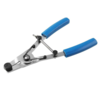nobody here is an expert on it, but my guess is any HH friction rated brake pad is going to work more or less the same as any other HH pad, regardless of its "aggressiveness". If anything, ridges will reduce the contact patch of the pad, you can't do any better than a flat surface in that regard.If you have a chance to study the two systems, the front pads on the ABSII are much more 'aggressive' to me (ridges versus flat surface) and have significant additional pad surface compared to the standard front pads. (I have both so I have compared them more than once). I think it is just a matter of physics that more pad contact surface would mean more braking.
Regarding the additional pad surface of the ABS2 models, that's probably cancelled out by the smaller rotor diameter/radius compared to the non-ABS models. You have a stronger caliper working from a shorter distance from the axle, so its probably not all that much of an overall gain in stopping power, if any. It has to be stronger just to compensate for the fact that it has less leverage compared to the non-ABS.
Now, having ridden both, I was much more impressed with the apparent stopping power of the ABS2 model when I took one for a test ride, compared to the non-ABS model on my first test ride. There's no doubt in my mind that upon first application of the brakes, you will feel more confident with the ABS2 model. Where the difference becomes less noticeable is after you get familiar with the non-ABS brakes, and how to apply the front/rear brakes appropriately (Martin's analogue smoothness comment), you can approach the stopping power of the ABS2.
The difference is with the ABS2 bike you don't have to think about it, you just grab the lever and the system does the rest. With the non-ABS you have to gradually learn how to achieve maximum braking potential. Martin has practiced stopping his non-ABS model to it's limit, and I have no doubt that in a controlled situation he can equal or exceed the ABS2 braking capability, especially if the ABS2 is being ridden by a less experienced rider. But the key word is "controlled situation", given the choice in a panic stop situation I'd rather have the ABS2 than the non-ABS.



